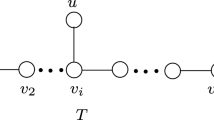Summary
We describe a procedure for reducing the number of edges of a given nonoriented network in such a way, that the shortest distances between the original vertices are conserved. It is based on the triangle condition and on generating additional vertices. For a network optimization problem, such as the travelling salesman problem, the procedure achieves an essential reduction of the number of variables and of the solution effort. The computational results show that the reduced number of edges depends about linearly on the number of vertices.
Zusammenfassung
Es wird ein Verfahren beschrieben, das die Anzahl der Kanten eines gegebenen ungerichteten Netzwerkes in der Weise verringert, daß die kürzesten Entfernungen zwischen den ursprünglichen Knoten erhalten bleiben. Es beruht auf der Anwendung der Dreiecksungleichung und der Erzeugung zusätzlicher Knoten. Das Verfahren bewirkt für Netzwerk-Optimierungsprobleme, etwa für das Rundreiseproblem, eine wesentliche Reduzierung der Anzahl der Variablen und des Lösungsaufwands. Die Rechenergebnisse zeigen, daß die reduzierte Anzahl der Kanten etwa linear von der Anzahl der Knoten des Netzwerks abhängt.
Similar content being viewed by others
References
Christofides N (1975) Graph theory, an algorithmic approach. Academic Press, London, New York
Dantzig G, Fulkerson DR, Johnson S (1954) Solution of a large scale travelling salesman problem. Oper Res 2:393–410
Fleischmann B (1982) Linear programming approaches to travelling salesman and vehicle scheduling problems. Paper presented at the XI International Symposium on Mathematical Programming, Bonn
Grötschel M (1977) Polyhedrische Characterisierungen kombinatorischer Optimierungsprobleme. Verlag A Hain, Meisenheim
Grötschel M (1980) On the symmetric travelling salesman problem: Solution of a 120-city problem. Math Progr Studies 12:61–77
Hakimi SL, Yau SS (1965) Distance matrix of a graph and its realizibility. Qu Appl Math 22:305–317
Held M, Karp RM (1962) A dynamic programming approach to sequencing problems. J SIAM 10:196–210
Karg LL, Thompson GL (1964) A heuristic approach to solving travelling salesman problems. Manag Sci 10:225–248
Laporte G, Miliotis P, Nobert Y (1981) Computational comparison of two methods for finding the shortest complete cycle or circuit in a graph. RAIRO 15:233–239
Miliotis P (1978) Using cutting planes to solve the symmetric travelling salesman problem. Math Progr 15:177–188
Murchland JD (1970) A fixed matrix method for all shortest distances in a directed graph and for the inverse problem. PhD Dissertation, Karlsruhe
Author information
Authors and Affiliations
Rights and permissions
About this article
Cite this article
Fleischmann, B. Distance conserving reductions for nonoriented networks. OR Spektrum 5, 195–205 (1983). https://doi.org/10.1007/BF01719842
Received:
Accepted:
Published:
Issue Date:
DOI: https://doi.org/10.1007/BF01719842




